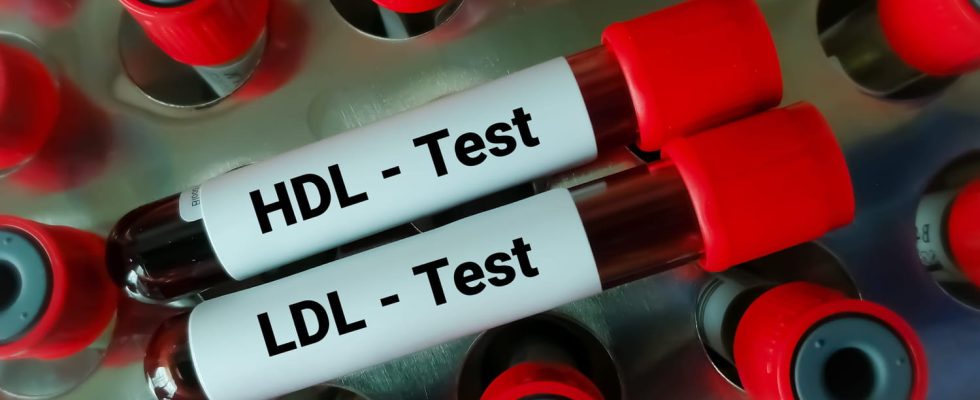High LDL cholesterol is bad for the arteries and increases the risk of cardiovascular diseases such as heart attack and stroke.
Cholesterol is a fat manufactured by the body and/or provided by food. It is carried in the blood by two proteins : one called the LDL cholesterol (low-density lipoprotein), the other is called HDL cholesterol (high-density lipoprotein).
→ LDL cholesterol (or LDL cholesterol) is the protein that transports cholesterol from the liver to the body’s cells, particularly in the arteries and it is called “bad cholesterol”. “LDL cholesterol can bring cholesterol where it shouldn’t and “clog” the arteries, which is why it is called “bad” cholesterol.“, explains Professor Gérard Helft, cardiologist and president of the French Federation of Cardiology.
→ HDL cholesterol (or HDL cholesterol) is the protein that brings cholesterol from different cells to the liver and it is called “good cholesterol”.
In what foods is bad cholesterol found?
LDL cholesterol is mainly found in foods of animal origin. Here are some examples of foods that contain cholesterol:
- Fatty meats: particularly red meats (beef, lamb) and offal
- High-fat dairy products like whole milk cheeses, whole milk, and cream
- Egg yolks
- Cold meats, sausages and processed meats
- Fried foods and donuts…
The total cholesterol level is measured whena blood test taken on an empty stomach. We do not measure LDL cholesterol directly but we evaluate it using the following formula (in grams/liter): LDL cholesterol = Total cholesterol – HDL cholesterol – Triglycerides / 5. All of these parameters appear in the blood test results. But what will especially interest doctors is the LDL cholesterol level.
What is the normal level of LDL cholesterol?
We can often read that an LDL cholesterol level is generally considered normal when it is between 0.9 and 1.6 g/L in adults. “In absolute, there is no real normal level of LDL cholesterol to the extent that the desirable level of “bad cholesterol” will depend on an individual’s other cardiovascular risk factors. That is to say that the “acceptable” level will not be the same in an individual who smokes, who has high blood pressure or diabetes, for example, as in a non-smoking, non-diabetic and non-hypertensive individual., insists our interlocutor. In other words, the level considered “normal” of bad cholesterol must be adapted and interpreted to the profile of the individual and depends on overall cardiovascular risk. Furthermore, the so-called normal figures are different from one laboratory to another.
“We now know that a very low LDL cholesterol level has no disadvantages”
What are the risks of high LDL cholesterol?
Too high a level of LDL cholesterol increases the risk ofatherosclerosiswhich corresponds to the progressive clogging of the walls of the arteries – in particular the arteries of the heart or the brain whose walls can thicken and deteriorate – and promote the risk of heart attack, stroke and arteritis. The risk of high LDL cholesterol levels is all the greater if it is combined with other cardiovascular risk factors such as diabetes, high blood pressure, smoking or being overweight, but also hereditary factors.
Is low LDL cholesterol a cause for concern?
“A few decades ago, there was concern that very low LDL cholesterol levels could increase the risk of hemorrhagic stroke. Risks of dementia, cognitive decline or cancer linked to very low cholesterol levels have also been pointed out. But today, we have scientific certainty (follow-up studies have been carried out) that very low LDL cholesterol has no disadvantages.“, replies the expert. On the other hand, we know that the lower the LDL cholesterol level, the better we are protected from cardiovascular diseases.
There are of course ways to lower your bad cholesterol levels.
→ In the first placethe reduction of cholesterol involves food:
- Choose the right fats (favor vegetable oils (except palm oil), fatty fish, oilseeds, etc.)
- Increase the consumption of foods rich in fiber (fruits and vegetables, cereals, etc.)
- Reduce bad fats (fatty meats, cold meats, whole milk products, etc.)
- Reduce foods high in cholesterol such as egg yolk, organ meats or fatty cheeses
- At the same time, have regular physical activity and fight against excess weight
- Avoid smoking to avoid accumulating cardiovascular risk factors
→ In second level and depending on the individual’s needs (if their LDL cholesterol level and therefore their overall cardiovascular risk factor remains high), we can consider the prescription of medications (statins) which help reduce cholesterol levels. “But before initiating drug treatment, the overall cardiovascular risk should be assessed, ideally by a doctor. Firstly, the patient can evaluate their risk score on the website of the French Federation of Cardiology via a very simple test which is done in a few minutes“, concludes Professor Helft.
Thanks to Professor Gérard Helft, cardiologist and president of the French Federation of Cardiology.
